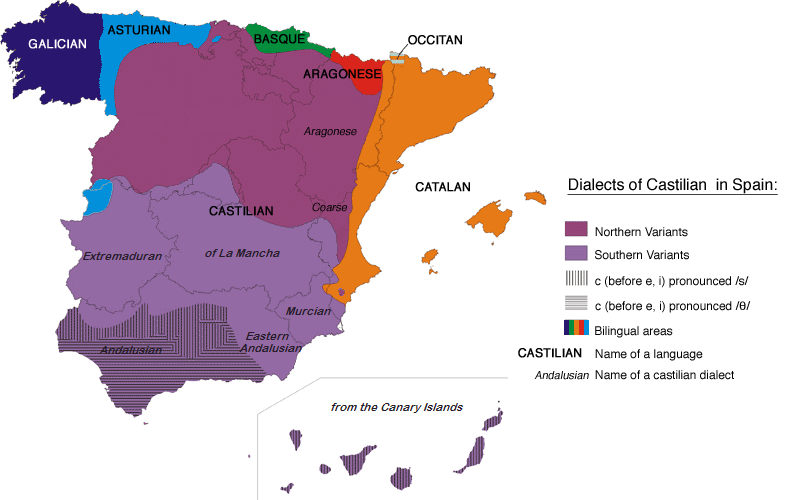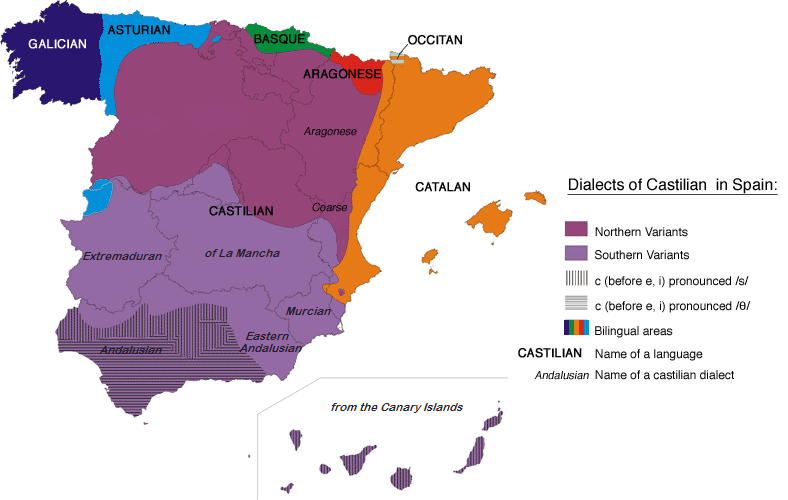Under Alfonso X of Castilla & León (r. 1252-1284), however, Castilian Spanish began to gain the upper hand. Although Alfonso personally contributed a lot to medieval Galician poetry, it was he who first established Castilian as the official language of his courts, replacing Latin. Later on, western Castilla would join up with eastern Aragón when Ferdinand and Isabella got married in 1469, but the two realms remained distinct kingdoms with a single monarch.
After the 18th-century War of the Spanish Succession (a dynastic struggle/civil war), the new king Felipe V issued the Nueva Planta decrees that made Castilian laws universal throughout the country and Castilian the language of government. He did this partly to centralize Spain and partly to punish the regions of Aragón, Cataluña, and Valencia, which had opposed him in the war (and which also spoke Aragonese and Catalan).
The last major threat to Spain’s minority languages came during the dictatorship of Francisco Franco, who led the conservative Nationalists to victory in the Spanish Civil War (1936-1939). Although he himself was born in Galicia, his ideology of conformity (called National Catholicism) mandated Castilian Spanish as the sole official language of the state; it became a crime to speak Galician in public, for example.
However, after Franco died and King Juan Carlos I initiated la Transición to liberal democracy, the new constitution enshrined protections for minority languages, four of which are now co-official in their respective regions. Today, once critically-endangered languages are making a comeback and Galician, Basque, and Catalan are stronger than ever before in recent history.
In this post I would like to introduce eight Spanish languages other than what we typically think of as “Spanish.”
Galician
Native name: galego
Number of speakers: 3 million
Description and status: I always like to describe
Galician as an un-nasalized Portuguese, written like Spanish, and spoken with Italian intonation. Galician and Portuguese are actually extremely closely-related languages (some activists argue that they’re merely dialects of the same language), but after Portugal gained its independence in the 12th century, the two went their separate ways. In the Middle Ages, Galician enjoyed prestige as a language of poetry and law, but the creeping influence of Castilian ousted it before long. Although it historically has been stigmatized in the big cities as a rural dialect, Galician experienced a literary rebirth in the 1800s and is co-official in the modern-day Community of Galicia.
Very similar to Galician is Fala (“Speech”), hidden away in isolated valleys of northwest Extremadura. Its tiny but strong community of speakers can easily communicate with Galician speakers, although they prefer to distinguish Fala as its own language. Fascinating stuff.
Example text: Tódolos seres humanos nacen libres e iguais en dignidade e dereitos e, dotados como están de razón e conciencia, díbense comportar fraternalmente uns cos outros.
Astur-Leonese
Native names: asturianu, bable, llionés, estremeñu
Number of speakers: Asturian (100,000), Leonese (50,000), Extremaduran (200,000)
Description and status: It’s hard to say whether Astur-Leonese is a language with three dialects or a family of three very similar languages. Regardless, Astur-Leonese has roots in the northern region of Asturias—the only part of Spain never conquered by the Moors. During the Reconquista, it was adopted by the kingdom of León to the south and called Leonese, and was brought later into bordering Extremadura.Today, the language is protected in the Principality of Asturias, and while it’s not co-official, it is taught in public schools and is promoted in the media. In the provinces of León and Zamora to the south, however, Astur-Leonese is extremely endangered and little official work has been done to preserve it. Its situation in Extremadura isn’t much better, and even locals struggle to distinguish between Extremaduran Spanish and Extremaduran proper.
Example text: Tolos seres humanos nacen llibres y iguales en dignidá y drechos y, pola mor de la razón y la conciencia de so, han comportase hermaniblemente los unos colos otros.
Basque
Native name: euskara
Number of speakers: 700,000
Description and status: Perhaps the most unique language in all of Europe, Basque is a
language isolate—it’s related to no living language anywhere! Its current range around the Bay of Biscay on either side of the Pyrenees Mountains would have been much larger during Roman times, when it was one of many non-Latin languages spoken in the area. However, only Basque has survived to the present day and, despite persecution under Franco, is actually growing in its number of speakers. Co-official in the Basque Country region and in northern next-door Navarra, it’s strongest in the provinces represented by
Bilbao and
San Sebastián. You can recognize the written language by its plethora of Ks and Zs, and Basque and Spanish share many sounds in common.
Example text: Gizon-emakume guztiak aske jaiotzen dira, duintasun eta eskubide berberak dituztela; eta ezaguera eta kontzientzia dutenez gero, elkarren artean senide legez jokatu beharra dute.
Aragonese
Native name: aragonés, fabla
Number of speakers: 10,000
Description and status: Like the medieval kingdom of Aragón, the Aragonese language began in the foothills of the central Pyrenees and gradually spread south. However, over the centuries, Castilian replaced its cousin Aragonese in much of this region, and the language is now spoken only in far-northern Huesca and Zaragoza provinces. Aragón is sparsely populated as it is (Zaragoza the capital has over half the population!), so it’s not surprising that just 10,000 or so speak the language. Under Franco, it was sadly ridiculed as poorly-spoken Castilian, but today it’s protected by the regional government as Aragón’s “native language,” although it isn’t co-official.
Example text: Toz os ombres naxen libres y iguals en dinidat y en dreitos. Adotatos de razón y de conzenzia, deben apachar-sen unos con atros d’una manera freternal.
Aranese (Occitan)
Native name: aranés, gascon, occitan
Number of speakers: 5,000
Description and status: Despite being so tiny, Aranese is actually one of three co-official languages in the Cataluña region. Used only in the Aran Valley of the Pyrenees, Aranese is technically a dialect of Gascon, which itself is a variety of Occitan—a Romance language spoken across southern France. I honestly know zilch about Aranese, but I do know it’s super close to Catalan (see below) and has some complex pronunciation rules.
Example text: Ah! petit prince, atau comprení, pòga pòc, era tua petita vida melancolica. En molt de temps non auies agut per distracion qu’era doçor deth solei quan se cògue… Sabí aguest nau detalh, eth quatau dia ath maitin, quan me diguís: M’agrade veir quan eth solei se cògue.
Catalan
Native name: català, valencià
Number of speakers: 9 million
Description and status: While linguists usually group Galician, Astur-Leonese, Castilian, and Aragonese together, Catalan is a whole ‘nother ball game, and is actually more similar to languages in southern France than to Spanish. (However,
it is NOT a mixture of French and Spanish!) Primarily spoken and co-official in the regions of Cataluña, Valencia, and the Balearic Islands, Catalan actually has more speakers than Croatian, Danish, or Finnish do. Like Galician, Catalan was a legal and literary language in the Middle Ages and went through a renaissance in the 1800s. Catalans are especially proud of their mother tongue, and it plays a large role in their quest for secession from Spain. Valencians, on the other hand, believe they speak a separate language—but I guess there is that saying that “a language is a dialect with an army.”
Example text: Tots els éssers humans neixen lliures i iguals en dignitat i en drets. Són dotats de raó i de consciència, i han de comportar-se fraternalment els uns amb els altres.
Gomeran whistle
Native name: el silbo gomero (in Spanish)
Number of speakers: under 20,000
Description and status: La Gomera is a small, circular island in the Canaries crossed by ravines, hills, and valleys. Because of this, the pre-Spanish Guanche people developed a complex way of whistling that allowed them to communicate over long distances by whistling their language. Although the Guanche language went extinct after the Spanish conquest of the islands, the skill was passed on to Spanish-speakers, who continue to use it today. El silbo isn’t technically a language but a way of making it easier to speak Canarian Spanish across the island’s rugged terrain. Check out the YouTube video below!
Iberian Romani
Native name: caló
Number of speakers: 40,000
Description and status: Spoken almost exclusively by Spain’s Gypsy population (a.k.a. the Romani people), the caló language is actually a “mixed” language that takes Spanish grammar and replaces most Spanish words with a totally different lexicon. Remember that modern-day Gypsies are descendants of nomadic people from northern India who migrated to Europe centuries ago; hence, Iberian Romani takes a lot of its vocabulary from the ancestral spoken language but operates using Spanish grammatical rules.
I actually encountered el caló at my school last year: I was in a second-grade bilingual science class talking about words for food in English when the teacher asked one of the Gypsy boys what the word for “oil” was in his language, and he replied with the word “ampio.” So cool!
Example text:
Y sasta se hubiese catanado sueti baribustri, baribustri, y abillasen solictos á ó de los fores, os penó por parabola: Manu chaló abri á chibar desqueri simiente: y al chibarle, yeque aricata peró sunparal al drun, y sinaba hollada, y la jamáron as patrias e Charos. Y aver peró opré bar: y pur se ardiñó, se secó presas na terelaba humedad. Y aver peró andré jarres, y as jarres, sos ardiñáron sat siró, la mulabáron. Y aver peró andré pu lachi: y ardiñó, y diñó mibao á ciento por yeque. Penado ocono, se chibó á penar á goles: Coin terela canes de junelar, junele. — “Parable of the Sower” (Luke 8:4-8)
Sources
*
Wikipedia: Languages of Spain,
Galician,
Fala,
Astur-Leonese,
Asturian,
Leonese,
Extremaduran,
Basque,
Aragonese,
Aranese,
Gascon,
Occitan,
Catalan,
Gomeran whistle,
Caló, this
blank map of Spain used for the maps


 Sé tú el periodista: envíanos tus fotos o noticias a través de Telegram.
Sé tú el periodista: envíanos tus fotos o noticias a través de Telegram.








